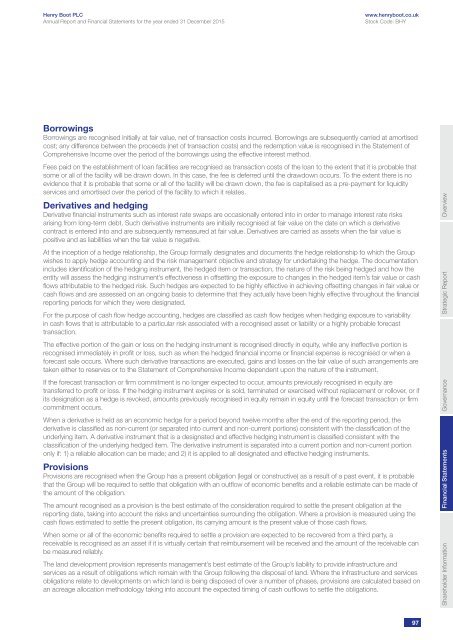Cohesive Consistent Confident
4mZ0Bv
4mZ0Bv
You also want an ePaper? Increase the reach of your titles
YUMPU automatically turns print PDFs into web optimized ePapers that Google loves.
Henry Boot PLC<br />
Annual Report and Financial Statements for the year ended 31 December 2015<br />
www.henryboot.co.uk<br />
Stock Code: BHY<br />
Borrowings<br />
Borrowings are recognised initially at fair value, net of transaction costs incurred. Borrowings are subsequently carried at amortised<br />
cost; any difference between the proceeds (net of transaction costs) and the redemption value is recognised in the Statement of<br />
Comprehensive Income over the period of the borrowings using the effective interest method.<br />
Fees paid on the establishment of loan facilities are recognised as transaction costs of the loan to the extent that it is probable that<br />
some or all of the facility will be drawn down. In this case, the fee is deferred until the drawdown occurs. To the extent there is no<br />
evidence that it is probable that some or all of the facility will be drawn down, the fee is capitalised as a pre-payment for liquidity<br />
services and amortised over the period of the facility to which it relates.<br />
Derivatives and hedging<br />
Derivative financial instruments such as interest rate swaps are occasionally entered into in order to manage interest rate risks<br />
arising from long-term debt. Such derivative instruments are initially recognised at fair value on the date on which a derivative<br />
contract is entered into and are subsequently remeasured at fair value. Derivatives are carried as assets when the fair value is<br />
positive and as liabilities when the fair value is negative.<br />
At the inception of a hedge relationship, the Group formally designates and documents the hedge relationship to which the Group<br />
wishes to apply hedge accounting and the risk management objective and strategy for undertaking the hedge. The documentation<br />
includes identification of the hedging instrument, the hedged item or transaction, the nature of the risk being hedged and how the<br />
entity will assess the hedging instrument’s effectiveness in offsetting the exposure to changes in the hedged item’s fair value or cash<br />
flows attributable to the hedged risk. Such hedges are expected to be highly effective in achieving offsetting changes in fair value or<br />
cash flows and are assessed on an ongoing basis to determine that they actually have been highly effective throughout the financial<br />
reporting periods for which they were designated.<br />
For the purpose of cash flow hedge accounting, hedges are classified as cash flow hedges when hedging exposure to variability<br />
in cash flows that is attributable to a particular risk associated with a recognised asset or liability or a highly probable forecast<br />
transaction.<br />
The effective portion of the gain or loss on the hedging instrument is recognised directly in equity, while any ineffective portion is<br />
recognised immediately in profit or loss, such as when the hedged financial income or financial expense is recognised or when a<br />
forecast sale occurs. Where such derivative transactions are executed, gains and losses on the fair value of such arrangements are<br />
taken either to reserves or to the Statement of Comprehensive Income dependent upon the nature of the instrument.<br />
If the forecast transaction or firm commitment is no longer expected to occur, amounts previously recognised in equity are<br />
transferred to profit or loss. If the hedging instrument expires or is sold, terminated or exercised without replacement or rollover, or if<br />
its designation as a hedge is revoked, amounts previously recognised in equity remain in equity until the forecast transaction or firm<br />
commitment occurs.<br />
When a derivative is held as an economic hedge for a period beyond twelve months after the end of the reporting period, the<br />
derivative is classified as non-current (or separated into current and non-current portions) consistent with the classification of the<br />
underlying item. A derivative instrument that is a designated and effective hedging instrument is classified consistent with the<br />
classification of the underlying hedged item. The derivative instrument is separated into a current portion and non-current portion<br />
only if: 1) a reliable allocation can be made; and 2) it is applied to all designated and effective hedging instruments.<br />
Provisions<br />
Provisions are recognised when the Group has a present obligation (legal or constructive) as a result of a past event, it is probable<br />
that the Group will be required to settle that obligation with an outflow of economic benefits and a reliable estimate can be made of<br />
the amount of the obligation.<br />
The amount recognised as a provision is the best estimate of the consideration required to settle the present obligation at the<br />
reporting date, taking into account the risks and uncertainties surrounding the obligation. Where a provision is measured using the<br />
cash flows estimated to settle the present obligation, its carrying amount is the present value of those cash flows.<br />
When some or all of the economic benefits required to settle a provision are expected to be recovered from a third party, a<br />
receivable is recognised as an asset if it is virtually certain that reimbursement will be received and the amount of the receivable can<br />
be measured reliably.<br />
The land development provision represents management’s best estimate of the Group’s liability to provide infrastructure and<br />
services as a result of obligations which remain with the Group following the disposal of land. Where the infrastructure and services<br />
obligations relate to developments on which land is being disposed of over a number of phases, provisions are calculated based on<br />
an acreage allocation methodology taking into account the expected timing of cash outflows to settle the obligations.<br />
Shareholder Information Financial Statements<br />
Governance<br />
Strategic Report<br />
Overview<br />
97


